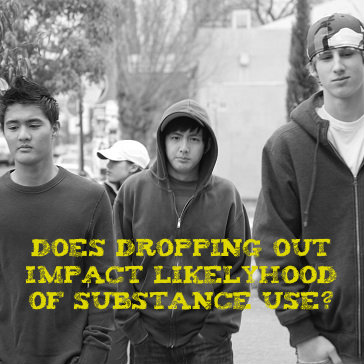Does Dropping Out Really Impact Substance Use Rates?
Substance use is common in a substantial minority of high school-age children across the U.S. Significant numbers of high school-age children also discontinue their education, or drop out, before receiving a diploma and never complete an alternative GED program. In 2013, officials from the federal Substance Abuse and Mental Health Services Administration released a report that examined the connection between dropping out of high school and the risks for involvement in substance use. Information for this report came from nine years of data gathered from a project called the National Survey on Drug Use and Health.
Dropout Rates
The U.S. Department of Education tracks high school dropout rates in a couple of ways. One method involves counting the percentage of people between the ages of 16 and 24 who do not attend high school and don’t possess a high school diploma, a GED certificate or any other certificate from a recognized, alternative educational program. In 2011, the last year for which full figures are available, 7 percent of individuals in the target age range who were not institutionalized or incarcerated fit this definition. High school dropout rates can also be roughly calculated by seeing how many incoming freshman go on to receive a diploma within a standard four-year timeframe. Three out of every four students successfully graduate on time, while the remaining 25 percent do not. Apart from any substance-related issues, common consequences of dropping out of high school include making less money, not receiving health insurance coverage and having increased risks for poverty and serious health issues.
 Teen Substance Use Rates
Teen Substance Use Rates
The National Institute on Drug Abuse regularly tracks trends for substance intake in U.S. 8th graders, 10th graders and 12th graders. With the exception of involvement with inhalants, older teenagers consistently engage in substance use more often than younger teens. For example, in 2012 over 40 percent of 12th graders drank alcohol in an average month, while only 27.6 percent of 10th graders drank as frequently. Similarly, while almost 23 percent of all 12th graders used marijuana on a monthly basis, only 17 percent of 10th graders used the drug as frequently. Percentages of monthly alcohol and marijuana use were even lower in 8th graders. Marijuana ranks as the most common drug choice among all high school students.
How Dropping Out Influences Substance Use Rates
In the report published by the Substance Abuse and Mental Health Services Administration, researchers used data gathered from the National Survey on Drug Use and Health between 2002 and 2010 to identify high school-age children who had dropped out by the 12th grade and determine how dropping out influences substance use rates. The survey’s results indicate that 13.2 percent of teens old enough to be in the 12th grade failed to graduate in this nine-year timespan. The dropout rate among boys was 14.7 percent, while the rate among girls was 11.6 percent. The ethnic groups most likely to drop out before or during the 12th grade were Native Americans/Alaskan Natives and Hispanics. Asian Americans and whites had the lowest dropout rates.
When compared to 12th graders who stayed in high school, dropouts of the same age had consistently higher monthly rates for all forms of substance use. For example, while only 22.4 percent of all enrolled 12th graders smoked cigarettes, 56.8 percent of all dropouts the same age smoked. While 35.3 percent of enrolled 12th graders drank alcohol, 41.6 percent of all dropouts the same age drank. Twelfth grade-age dropouts also had a higher rate of participation in a form of dangerous, short-term alcohol consumption called binge drinking. In addition, while 18.2 percent of all enrolled 12th graders used marijuana or some other illegal or illicit drug, 31.4 percent of all dropouts the same age used an illicit/illegal drug.
When compared to their gender, peers who remained in school, both 12th grade-age dropout boys and 12th grade-age dropout girls had significantly higher rates of intake for all commonly used substances. White 12th grade-age dropouts also had higher rates of intake for all substances than white 12th graders enrolled in school. The same pattern held true for African-American 12th grade-age dropouts and African-American 12th graders still attending school. Hispanics also largely followed the same pattern; however, the alcohol use rate was slightly higher among 12th grade Hispanics still enrolled in school than among Hispanic dropouts the same age. The two groups also had almost equal rates for participation in prescription drug abuse.
Importance Of Substance Abuse Prevention
The findings published by the Substance Abuse and Mental Health Services Administration clearly indicate that people who drop out of high school have substantially higher chances of becoming involved in substance use than their peers who remain in school. In the future, public health officials can use this information to place special emphasis on substance abuse prevention efforts aimed at teenagers and young adults who did not graduate from high school.
Read More About Teen Substance Abuse



